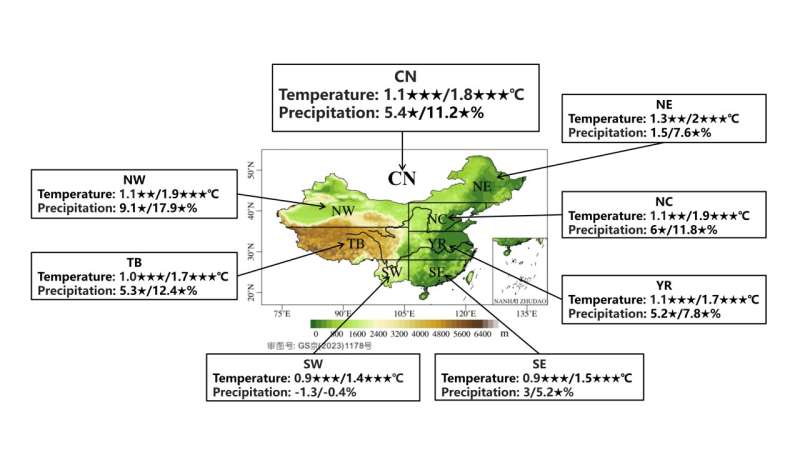This article has been reviewed according to Science X's editorial process and policies. Editors have highlighted the following attributes while ensuring the content's credibility:
fact-checked
peer-reviewed publication
trusted source
proofread
Intercomparison of multi-model ensemble-processing strategies for climate projection in China

A new study led by Prof. Zhihong Jiang at Nanjing University of Information Science and Technology and Prof. Laurent Li at Laboratoire de Météorologie Dynamique, CNRS has been published in Science China Earth Sciences.
The research team constructed a consistent framework of climate simulation, and used it to evaluate the performance of five multi-model ensemble-processing strategies. Temperature and precipitation changes over China and its seven subregions were then projected with an optimal scheme, which relies on climate model weighting by independence and performance (ClimWIP) at 1.5 and 2° C global warming levels.
The team found that more elaborated ensemble-processing strategies outperform the simple method of multi-model ensemble mean, and provide reasonably consistent median temperature and precipitation projections, with reduction of uncertainty (smaller inter-model spread) and augmentation of robustness (larger signal-to-noise ratio). ClimWIP turned out to be the optimal method with good performance in simulating current climate metrics.
ClimWIP was then deployed for the projection of future climate across China. When averaged over whole China under 1.5/2° C global warming levels (relative to pre-industrial), the annual-mean surface air temperature increases by 1.1/1.8° C (relative to 1995–2014), while the total precipitation increases by 5.4/11.2%, respectively. The projection for temperature is nevertheless more confident than for precipitation.
The largest warming is located in northeastern China, with increase of 1.3/2.0° C, followed by northern and northwestern China. The smallest but the most robust warming is in southwestern China, with values exceeding 0.9/1.5° C. For precipitation, northwestern China has the most robust projection and the largest increase by 9.1/17.9%, followed by northern China, where the increase is by 6.0/11.8%. The precipitation projection shows large uncertainty in southwestern China, even with uncertain sign of variation.
It is believed that the projection of future regional climate over China, based on the optimal multi-model ensemble-processing method, can enhance confidence in future climate projections, and provide useful information for assessing impacts, identifying risks, and making adaptation decisions.
More information: Huanhuan Zhu et al, Intercomparison of multi-model ensemble-processing strategies within a consistent framework for climate projection in China, Science China Earth Sciences (2023). DOI: 10.1007/s11430-022-1154-7
Journal information: Science China Earth Sciences
Provided by Science China Press



















